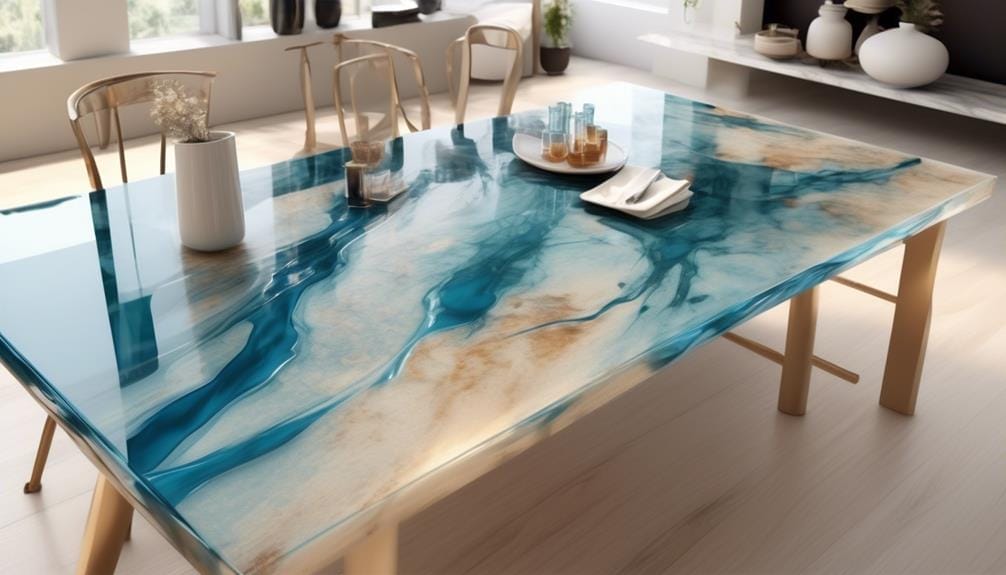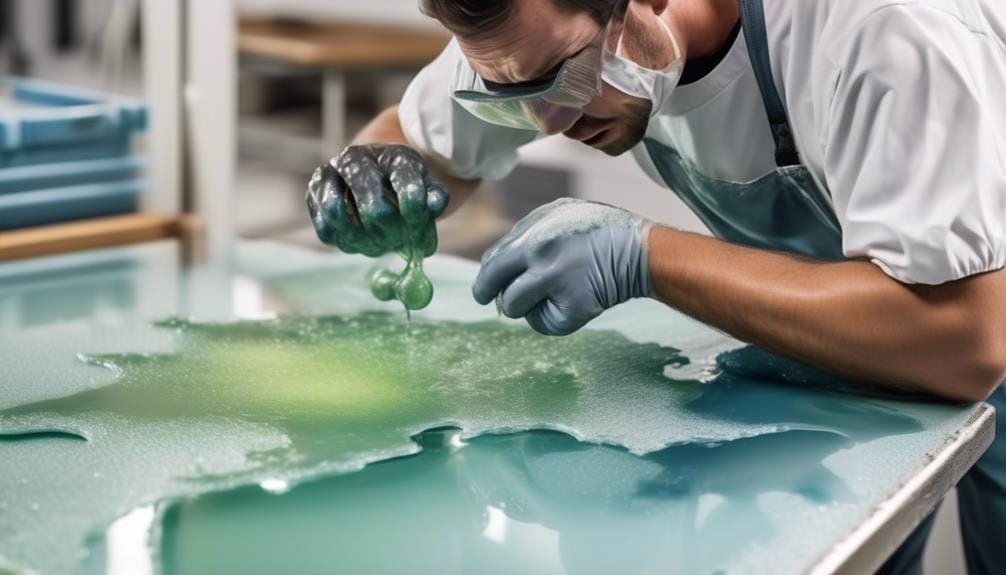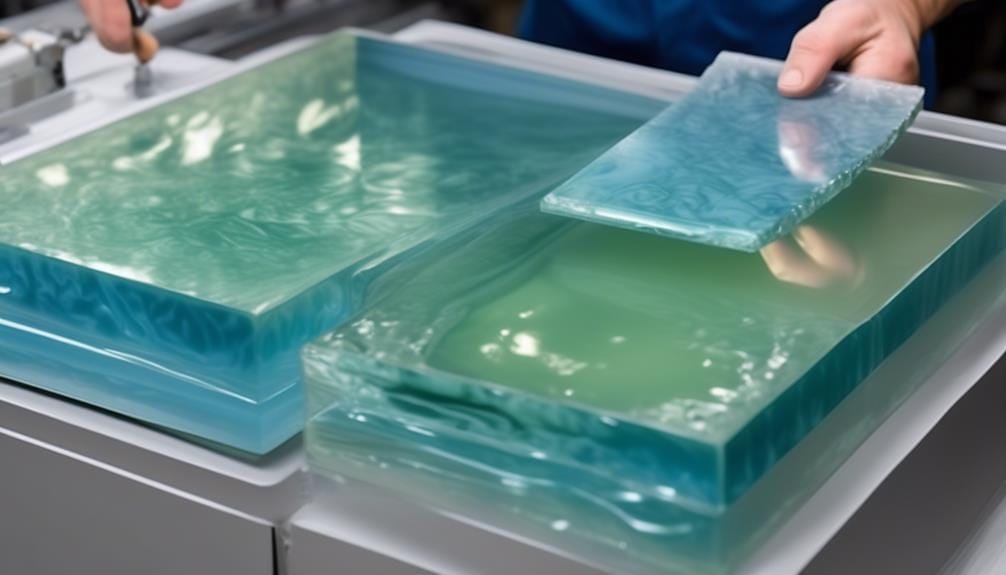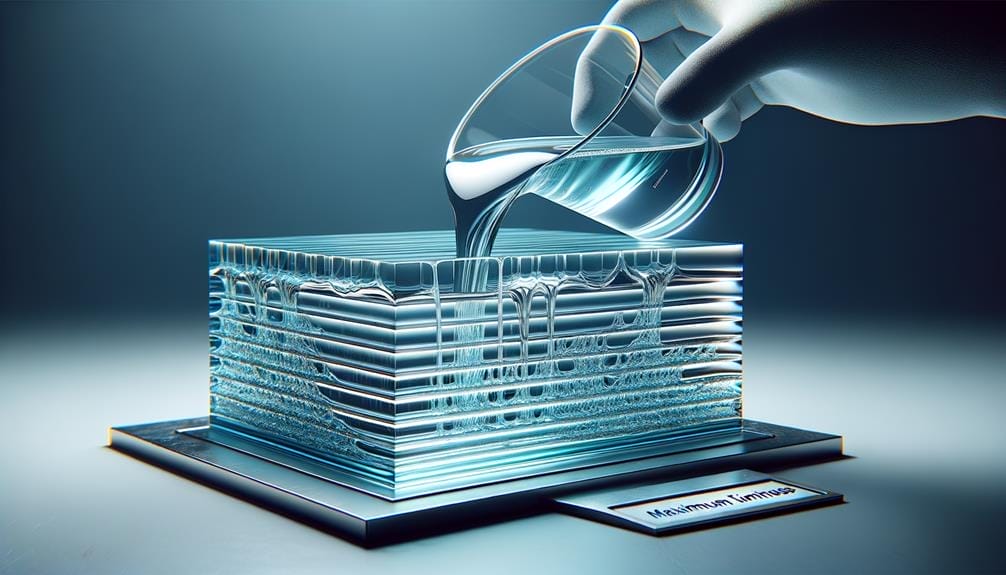Discovering the delicate dance of determining the thickness limit of Liquid Glass Epoxy has captivated countless craftsmen and artisans. As you embark on this exploration, envision the endless possibilities that await when pushing the boundaries of this versatile material.
But beware, for the thickness limit is a fickle friend, capable of both unlocking extraordinary feats and delivering disastrous consequences.
So, dear reader, let us embark on this journey together, unraveling the secrets of Liquid Glass Epoxy’s thickness limit while navigating the treacherous path of possibilities and pitfalls that lie ahead.
Key Takeaways
- Exceeding the thickness limit of liquid glass epoxy can have detrimental effects on curing, structural integrity, and UV resistance.
- Factors such as deep pour capability, project type, and pigment-to-epoxy ratio affect the thickness limit.
- Testing methods such as pour tests, depth gauges, and temperature evaluations can help determine the optimal thickness.
- Recommended thickness ranges vary for different applications, such as large casting projects, sunlight-exposed projects, wood projects, and colored epoxy finishes.
Importance of Thickness Limit
The importance of adhering to the thickness limit can’t be overstated when it comes to ensuring the proper curing and structural integrity of the liquid glass epoxy product. The thickness limit is a critical factor that determines the success and longevity of your epoxy project. Exceeding the recommended thickness limit can have detrimental effects on the curing process and overall performance of the epoxy.
Liquid glass epoxy, such as Glass® Deep Pour Epoxy or SuperClear® Liquid Glass, is specifically designed to have a deep pour capability. However, it’s essential to respect the thickness limit to achieve the desired results. When the epoxy is applied within the recommended thickness range, it can cure properly, ensuring maximum strength and durability.
By staying within the thickness limit, you can also maintain the highest UV yellowing resistance. This is particularly important for projects like clear epoxy resin wood filler or superb-colored epoxy, where exposure to sunlight can cause discoloration and degradation over time. Additionally, adhering to the thickness limit prevents excessive heat generation during the curing process, minimizing the risk of cracking or warping.
To enhance the aesthetic appeal of your epoxy project, you may consider incorporating mica powders like black from Black Diamond Pigments or experimenting with metallic epoxy. However, it’s crucial to remember that even when using additives, the thickness limit shouldn’t be exceeded.
Factors Affecting Thickness Limit
Exceeding the recommended thickness limit for liquid glass epoxy can compromise the curing process and overall performance, leading to potential issues with structural integrity and durability. Several factors can affect the thickness limit of liquid glass epoxy.
One important factor is the deep pour capability of the epoxy resin. Liquid glass epoxy is specifically designed for deep pour applications, with a range of 2-6 inches. Going beyond this recommended range can hinder the resin’s ability to cure properly and may result in a weak and brittle final product.
Another factor to consider is the type of project and material being used. Liquid glass epoxy is renowned for its exceptional performance on wood surfaces. It provides unmatched durability and strength, making it ideal for various DIY projects. When filling large voids in wood, the resin’s thickness should be carefully controlled. Using too much epoxy may lead to excessive heat buildup during the curing process, potentially causing cracks or bubbles in the final result.
Additionally, the incorporation of color and metallic epoxy pigments can affect the thickness limit. The addition of pigments can alter the resin’s viscosity, making it thicker and more challenging to pour. It’s crucial to follow the manufacturer’s guidelines regarding the recommended pigment-to-epoxy ratio to ensure optimal performance and curing.
Lastly, the UV resistance of liquid glass epoxy should be considered. While the epoxy provides excellent UV yellowing resistance, excessive thickness can impact its ability to withstand long-term sun exposure. It’s important to strike a balance between thickness and the desired level of UV protection.
Testing Methods for Determining Thickness Limit

To determine the thickness limit of liquid glass epoxy, various testing methods can be employed.
One common method is the pour test, where the epoxy resin is poured into a mold or container of known dimensions. By gradually increasing the amount of epoxy poured, you can observe the point at which the resin starts to overflow or exceed the desired thickness. This allows you to determine the maximum thickness that can be achieved without any structural issues or uneven curing.
Another testing method involves using a depth gauge to measure the thickness of the epoxy resin as it cures. By pouring the liquid glass epoxy into a mold or container and periodically measuring the depth at different time intervals, you can track the rate at which the epoxy sets and determine the maximum acceptable thickness based on the desired curing time.
Additionally, you can perform a temperature test to evaluate the effect of temperature on the epoxy resin’s curing process. By pouring the liquid glass epoxy at different temperatures and monitoring the curing time and thickness achieved, you can identify the optimal temperature range for achieving the desired thickness limit.
Consequences of Exceeding Thickness Limit
One potential consequence of surpassing the recommended thickness limit for Liquid Glass® Deep Pour epoxy is compromising its structural integrity and the effectiveness of its curing process.
Exceeding the deep pour capability of 2-6 inches can have detrimental effects on the epoxy. Thicker pours beyond the recommended limits can lead to excessive heat generation, which in turn can cause the epoxy to crack, warp, or develop air pockets. This compromises the overall strength and stability of the epoxy, making it less suitable for applications where structural integrity is crucial.
Moreover, the extended curing time required for thicker pours can result in an uneven finish and prolonged project timelines. Inconsistent curing and potential resin exotherm issues due to exceeding the thickness limits may result in a subpar, unsatisfactory final product.
Additionally, excessive thickness can lead to an increased risk of yellowing and discoloration over time, impacting the aesthetic appeal of the epoxy.
Therefore, it’s essential to adhere to the recommended thickness limits to ensure the best performance and longevity of the Liquid Glass® Deep Pour epoxy.
Recommended Thickness Range for Different Applications

The recommended thickness range for different applications of Liquid Glass deep-pour epoxy varies depending on the specific project requirements. Here are the contextually relevant recommended thickness ranges for various applications of Liquid Glass Epoxy:
- Large Casting Projects: Liquid Glass Deep Pour Epoxy has a deep pour capability of 2-6 inches, making it suitable for casting projects that require a significant thickness. This range ensures proper curing and stability for larger applications.
- Sunlight-Exposed Projects: For projects that will be exposed to sunlight, such as outdoor furniture or art installations, SuperClear Liquid Glass 2 Thick Pour is recommended. It offers the highest UV yellowing resistance, ensuring long-lasting clarity and color stability even under direct sunlight.
- Wood Projects: When it comes to wood applications, Liquid Glass Deep Pour Epoxy is considered the best epoxy resin. It provides exceptional durability and strength, making it ideal for DIY projects like tables and countertops. The recommended thickness for wood projects will depend on the specific design and structural requirements.
- Colored Epoxy Finishes: Liquid Glass Deep Pour Epoxy is excellent for colored epoxy resin wood filler applications. It effectively fills large voids and enhances the appearance of wood. This epoxy resin works amazingly with metallic epoxy pigment, allowing for flawless mixing and creating stunning colored epoxy finishes for various artistic designs.
Tips for Achieving Optimal Thickness
When working towards achieving optimal thickness with Liquid Glass Deep Pour 24-Hour Cure Epoxy, there are several tips to consider that will help you achieve the desired results.
To begin with, it’s essential to start with smaller batches if you’re new to epoxy. This will allow you to perfect your technique before moving on to larger volumes. Additionally, using a fan to assist with airflow and reduce heat is beneficial when working with this epoxy. The fan helps to maintain a cool working environment, which is particularly important for larger volumes or thicker pours. Elevating the mold can also improve the results as it allows for better airflow.
Precise mixing and measuring are crucial for achieving optimal thickness. Be sure to follow the instructions carefully and use the recommended ratios provided. Sweeping back and forth while mixing will help to ensure a thorough blend and prevent any unmixed portions. It’s important to note that the Deep Pour 24-Hour Cure epoxy has the highest capability of 1 inch thick per pour. To prevent air bubbles, make sure to mix slowly and carefully and avoid over-mixing.
Lastly, consider the ambient temperature of your working environment. Epoxy cures quickly in warmer temperatures, so it’s recommended to work in a cooler space to allow for a longer working time.
Common Mistakes to Avoid When Working With Liquid Glass Epoxy

To ensure successful results when working with Liquid Glass Epoxy, it’s important to be aware of common mistakes that should be avoided. By understanding these pitfalls, you can achieve a professional outcome with your epoxy projects. Here are four common mistakes to avoid when working with Liquid Glass Epoxy:
- Exceeding the thickness limit: Liquid Glass Epoxy has a recommended thickness limit of 1/8 inch per layer. Exceeding this limit can result in uneven curing, bubbles, or a tacky finish. Ensure that you pour the epoxy in thin, even layers to achieve the best results.
- Improper surface preparation: Before applying Liquid Glass Epoxy, it’s crucial to prepare the surface properly. Clean the surface thoroughly, removing any dust, grease, or contaminants. Failure to do so can lead to poor adhesion and compromised durability.
- Inaccurate mixing: Properly mixing the resin and epoxy is essential for a clear finish. Measure and mix the components precisely according to the instructions provided by the manufacturer. Failing to do so can result in inconsistent curing, cloudiness, or a sticky surface.
- Poor pouring technique: When pouring the epoxy, take care to pour slowly and evenly. Avoid pouring too quickly or from too high above the surface, as this can introduce air bubbles into the epoxy. Bubbles can mar the clear finish and compromise the overall appearance of your project.
Enhancing Durability Within Thickness Limit
In order to enhance the durability of your epoxy projects while staying within the recommended thickness limit, it’s crucial to implement strategies that promote strength and longevity. When working with liquid glass epoxy, there are several techniques you can employ to achieve this goal.
Firstly, consider using a colored epoxy resin wood filler. By adding color to your epoxy, you not only enhance the visual appeal of your project but also increase its strength and durability. This is particularly beneficial for applications such as epoxy tables, where the wood is exposed to daily wear and tear.
Additionally, choose an epoxy resin that offers high UV resistance, such as the SuperClear Liquid Glass 2 Thick Pour. This ensures that your project maintains its crystal-clear appearance and color stability, even when exposed to sunlight. UV resistance is especially important for outdoor applications, where the epoxy is subjected to prolonged sunlight exposure.
Furthermore, when working with deep-pour epoxy, such as liquid glass deep-pour epoxy, make sure to follow the recommended thickness limit. While this epoxy allows for much thicker pours, exceeding the recommended limit can compromise the strength and durability of your project. If you need to achieve a thicker depth, consider applying multiple layers, allowing each layer to cure before adding the next.
Lastly, always apply a seal coat to your epoxy project. This additional layer acts as a protective barrier, enhancing the durability and longevity of your project. It helps to prevent scratches, stains, and other damage, ensuring that your epoxy project remains in pristine condition for years to come.
Potential Solutions for Thick Applications

For thicker applications of liquid glass epoxy, there are potential solutions that can be implemented to ensure optimal results. When working with thick applications, it’s important to consider the following potential solutions:
- Utilize Liquid Glass Deep Pour Epoxy: This epoxy resin has a deep pour capability of 2-6 inches, making it the ideal choice for thick applications. Its unmatched industry reputation ensures a professional outcome with the clearest finish.
- Choose SuperClear Liquid Glass 2 Thick Pour: This option offers the highest UV yellowing resistance, ensuring long-lasting clarity and color stability for thick applications exposed to sunlight. It’s the perfect solution for maintaining the desired aesthetic over time.
- Consider the Use of Metallic Epoxy Pigment: Liquid Glass Deep Pour Epoxy works amazingly well with metallic epoxy pigment. With this combination, you can achieve endless possibilities for artistic designs in your thick applications.
- Follow Recommended Mixing and Pouring Techniques: To achieve a smooth and clear finish in your thick applications, it’s crucial to adhere to the recommended mixing and pouring techniques. This will ensure convenience and a professional outcome.
Conclusion: Ensuring Success With Liquid Glass Epoxy Thickness
Achieve optimal results with liquid glass epoxy thickness by implementing the potential solutions discussed in the previous subtopic.
This section serves as the conclusion of the article, ‘Thickness Limit of Liquid Glass Epoxy.’ When pouring epoxy resin, thickness is a crucial factor to consider to ensure the success of your project. Liquid glass epoxy, with its deep pour capability of 2-6 inches, offers unmatched clarity and convenience. However, it’s important to stay within the recommended thickness limit to achieve the desired outcome.
By following the guidelines provided by the manufacturer for pouring thickness, you can ensure that your liquid glass epoxy project will be a success. It’s essential to select the appropriate liquid glass epoxy product that suits your project requirements. For thick applications, products such as Liquid Glass Deep Pour Epoxy or SuperClear Liquid Glass 2 Thick Pour are recommended. These products offer the ability to pour up to 6 inches deep, making them suitable for various applications.
Furthermore, consider the specific characteristics of the liquid glass epoxy you’re using. Some products, like SuperClear Liquid Glass 2 Thick Pour, provide excellent UV protection and resistance to yellowing, making them ideal for outdoor projects that require long-lasting clarity and color stability.
Frequently Asked Questions
How Thick Can You Pour Liquid Glass?
You can pour liquid glass to achieve different thicknesses by using various pouring techniques. Factors like viscosity and the curing process affect thickness. Molds and additives can help control and adjust thickness. Experimentation and understanding structural integrity are key.
What Is the Maximum Thickness of Epoxy?
The maximum thickness of epoxy depends on the curing process, factors affecting the thickness limit, heat resistance, achieving consistency, structural integrity, alternatives, challenges, limitations, chemical resistance, and tips for successful pours.
Can You Pour Epoxy 2 Inches Thick?
Yes, you can pour epoxy 2 inches thick. However, when pouring thicker layers, consider epoxy curing time, challenges of deep molds, preventing heat buildup, optimal clarity, temperature impact, strength testing, even thickness, alternative materials, and common mistakes to avoid.
How Thick Can You Pour Clear Epoxy Resin?
You can achieve an optimal curing time for clear epoxy resin by following specific techniques for achieving a smooth finish with thick pours and exploring the impact of temperature, strength, durability, and challenges in large-scale projects. Enhancing clarity, achieving even color distribution, and preventing imperfections.
Conclusion
In conclusion, understanding and adhering to the thickness limit of liquid glass epoxy is crucial for achieving successful results.
One interesting statistic to note is that the Deep Pour 24-Hour Cure epoxy has a deep pour capability of 2-6 inches, reducing work by 75% and providing convenience for large-scale applications.
By staying within the recommended thickness range, avoiding common mistakes, and enhancing durability, individuals can ensure the success of their projects using liquid glass epoxy.





